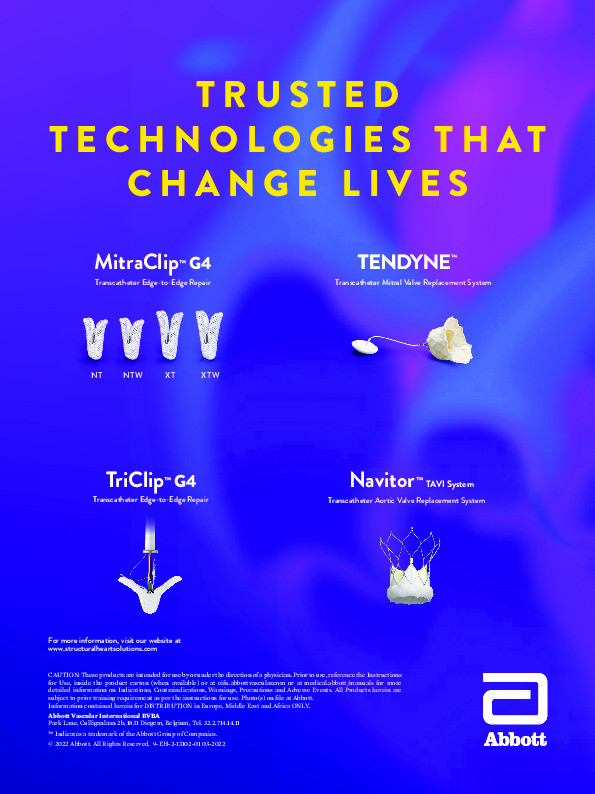We would like to thank Dr Tretter and colleagues for their Letter to the Editor1 and their careful read of our State-of-the-Art article recently published in EuroIntervention2. We understand their concern over the multiple nomenclatures of the tricuspid valve leaflets. We concur with the authors that the correct designation of anatomical structures is an important issue in medicine, the primary aim of which is to allow precise communication and to avoid misleading messages. For this reason, conventional nomenclature proven by the test of time should be preferred in order to avoid confusion. In a similar way, the widely accepted nomenclature of coronary arteries (i.e., left anterior descending and posterior descending artery) is attitudinally incorrect (being superior, and respectively inferior and running rather horizontally toward the apex, as the heart is oriented in the body).
In our review article and Supplementary Figure 3, we systematically address and illustrate the differences in the Valentine and attitudinal positions. Although we understand the authors' position of principle and acknowledge the value of their work that has contributed to a better understanding of the tricuspid valve anatomy, we would continue to advocate the use of a common language between the interventional imager and the interventionalist in daily clinical practice, rather than adherence to localisation of structures based solely on their position in the body. In our opinion, there are three main reasons enforcing this choice. First, the proposed nomenclature is derived from the traditional "surgical view" approach used for many years to communicate between imagers and surgeons. Second, since procedures are guided by transoesophageal echocardiography (TEE)3, the interventional imagers' "point of reference" is the position of the TEE probe within the oesophagus, relative to the cardiac structures of interest, corresponding to the Valentine view. Tretter and colleagues correctly state that three-dimensional views may be rotated in any direction, but the two-dimensional images are still the main standard across cardiovascular imaging modalities and are limited in reorientation planes. Thus, by naming the tricuspid valve leaflets based on consistent intracardiac anatomy (interventricular septum for the septal leaflet, anterior to the aorta for the anterior leaflet, and posterior to the anterolateral papillary muscle for the posterior leaflet), we maintain a common language among different two-dimensional imaging modalities (transthoracic echocardiography, TEE, cardiac magnetic resonance, cardiac computed tomography etc.,) that extends beyond individual anatomic variability. Third, the anatomic distortion accompanying right ventricular dilatation, as well as the numerous aetiologies and comorbidities of patients with severe tricuspid regurgitation, result in significant differences in the axis of the heart within the chest. Patients who have had prior open-heart surgery, often have horizontal hearts which are rotated clockwise, placing the right heart even more anteriorly and changing the location of the tricuspid valve leaflets. The rotation of the heart also varies with the position of the patient. While preprocedural TEE is performed in left lateral decubitus, interventions are done in the supine position; using a common language based on intracardiac structures and not body position, thus, has significant advantages.
The primary goal of any tricuspid intervention is the safe, accurate and efficacious placement of the device, typically using TEE guidance. Therefore, we strongly believe that the described nomenclature4, which reached consensus among the members of the PCR Tricuspid Focus group, a large community of experts who have been involved for many years in the field of tricuspid interventions, ensures effective and consistent communication between the interventionalist and the imager.
Conflict of interest statement
R. Hahn has received speaker fees from Boston Scientific, Baylis Medical, Edwards Lifesciences, and Medtronic; consulting fees for Abbott Structural, Edwards Lifesciences, Gore & Associates, Medtronic, Navigate, and Philips Healthcare; non-financial support from 3mensio; has equity with Navigate; and is the Chief Scientific Officer for the Echocardiography Core Laboratory at the Cardiovascular Research Foundation for multiple industry-sponsored trials, for which she receives no direct industry compensation. D. Muraru is part of the speakers bureau for GE Healthcare and received research equipment support from GE Vingmed. P. Lurz has served as a consultant for Abbott Structural Heart, Edwards Lifesciences, and Medtronic. J. Hausleiter has received speaker honoraria from Abbott Vascular, and Edwards Lifesciences. F. Maisano reports grant and/or research institutional support from Abbott, Medtronic, Edwards Lifesciences, Biotronik, Boston Scientific, NVT, and Terumo; consulting fees, honoraria (personal and institutional) from Abbott, Medtronic, Edwards Lifesciences, Xeltis, Cardiovalve, Occlufit, and Simulands; has royalty income/IP rights from Edwards Lifesciences; and is a shareholder (including share options) of Cardiogard, Magenta, SwissVortex, Transseptalsolutions, Occlufit, 4Tech, and Perifect. F. Praz has received travel expenses from Abbott Vascular, Edwards Lifesciences, and Polares Medical.
Supplementary data
To read the full content of this article, please download the PDF.

